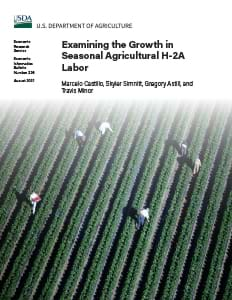Sep 23, 2021USDA report shows H-2A program rapidly expanding
The H-2A Agricultural Guest Worker program allows U.S. agricultural employers to hire foreign workers on a temporary or seasonal basis. The program rapidly expanded over the last decade, with certified H-2A positions increasing by more than 200% from 2010-19.
A recently released USDA Economic Research Service report explores how H-2A usage levels differ by agricultural sector, geography, and by the type of firm requesting workers.
What did the study find?
- The number of certified H-2A positions increased from 79,000 in 2010 to 258,000 in 2019. H-2A employment increased in most regions and sectors.
- H-2A employment growth was particularly strong in fruit and tree nuts and vegetables and melons. The combined share of H-2A positions ce
 rtified in these sectors increased from 49 to 67%.
rtified in these sectors increased from 49 to 67%. - H-2A employment by farm labor contractors (FLCs) expanded dramatically from 2010 to 2019. The FLC share of H-2A employment increased from 15 to 42%. FLC shares increased in all sectors though increases were more pronounced in fruit and tree nuts, and vegetables and melons.
- H-2A workers helped produce a wide array of labor-intensive commodities. The following commodities had the highest use of H-2A in 2019:
- Vegetables and melons (34% of total H-2A certifications): melons, tomatoes, lettuce, sweet potatoes, cucumbers, onions, and peppers.
- Fruit and tree nuts (33%): apples, blueberries, strawberries, citrus, cherries and peaches.
- Field crops (20%): tobacco, seed corn and sugarcane.
- Nursery and greenhouse (8%): nursery and greenhouse, Christmas trees, pine straw and hemp.
- Animal products (4%): open range livestock (including sheep, goats and cattle), bees, crawfish and horses.
- Most employers offered to pay H-2A workers hourly wages no greater than the region-specific adverse effect wage rate (AEWR), which is a minimum wage for H-2A workers set by the Department of Labor. Inflation-adjusted H-2A wages (in 2019 dollars) increased for all sectors from 2010 to 2019, on average by 26%.
- From 2010 to 2019, the average duration of an H-2A labor contract decreased from 6.7 to 5.3 months, a 20 percent decline. The nursery and greenhouse, and animal products sectors showed the most pronounced decreases.
- In 2019, H-2A employment was highest in states heavy in fruit, vegetable and melon production such as Florida, Washington, Georgia, California, and Michigan; tobacco growing States such as North Carolina and Kentucky; and crawfish and sugarcane producing States such as Louisiana. While most of the growth from 2010 to 2019 came from these large employers, H-2A employment increased in nearly every state.
- Growers in different states use the H-2A program with widely different intensities (as measured by the ratio of H-2A full-year jobs to total labor expenditures). Intensity is high in the Southeast and low in California and Texas.
– MARCELO CASTILLO, SKYLER SIMNITT, GREGORY ASTILL AND TRAVIS MINOR, USDA ERS







